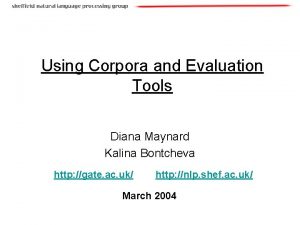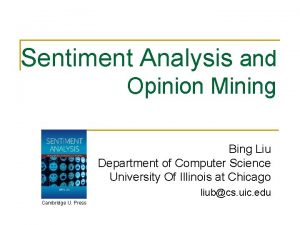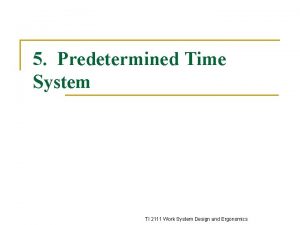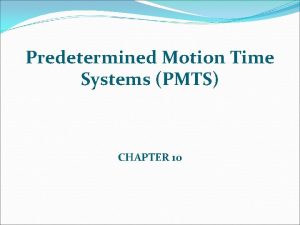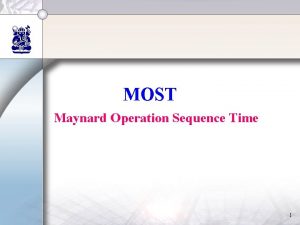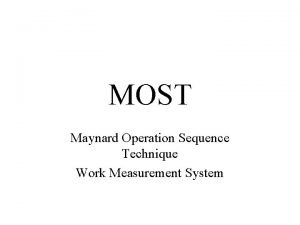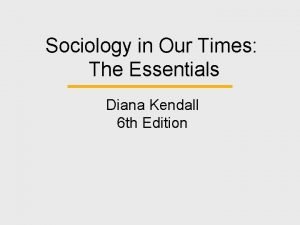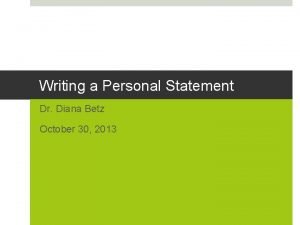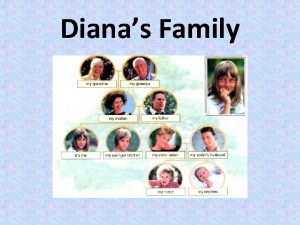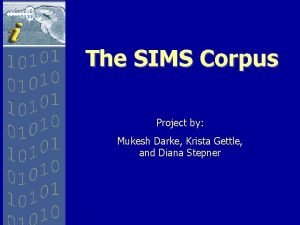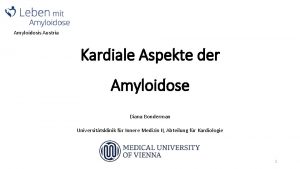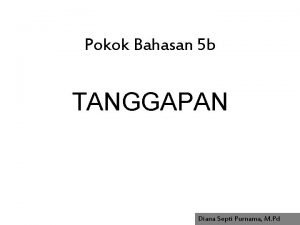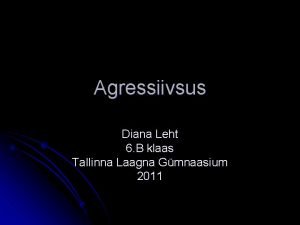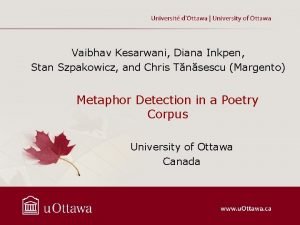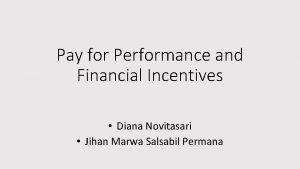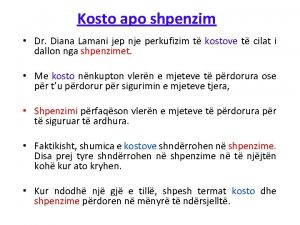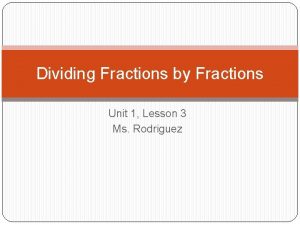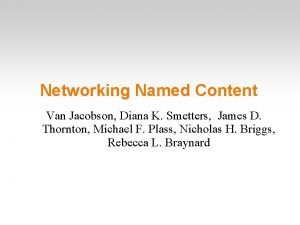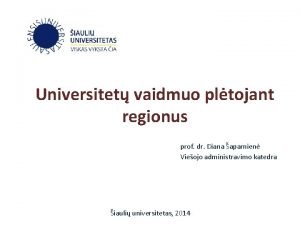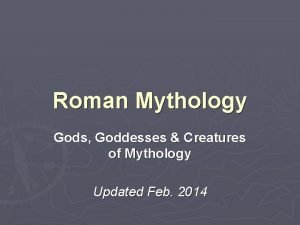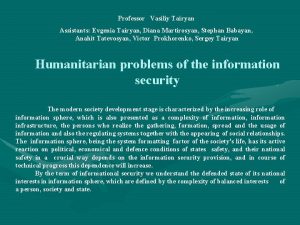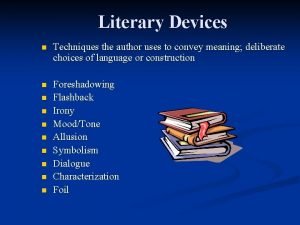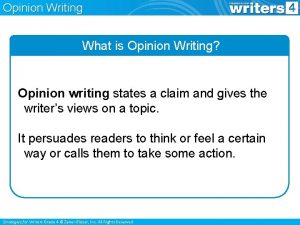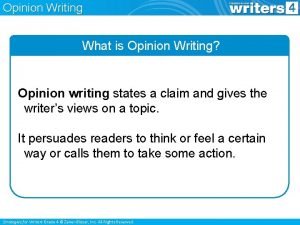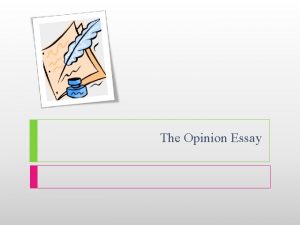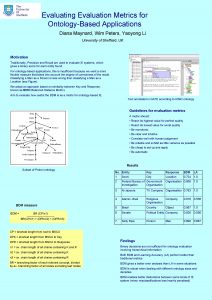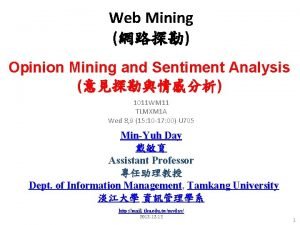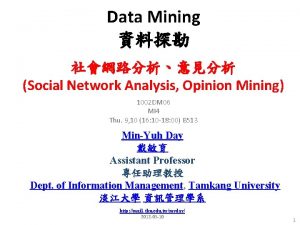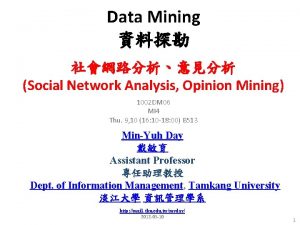Module 7 Opinion Mining Diana Maynard d maynardsheffield























































































































- Slides: 119

Module 7: Opinion Mining Diana Maynard (d. maynard@sheffield. ac. uk)

This session will be recorded Recorded video will be available after this session

Warning: these slides and hands-on material contain swear words and abusive terms

Aims of this session • Introduced the concept of Opinion Mining and look at some issues • Demonstrate simple examples of rule-based and ML methods for creating Opinion Mining applications • Consider how these can be extended / adapted • Examples of how deeper linguistic information can be useful • Practice with complex applications • Practice with ML

What is Opinion Mining? • A relatively recent discipline that studies the automatic extraction of opinions from text • More informally, it's about extracting the opinions or sentiments given in a piece of text • Also referred to as Sentiment Analysis (these terms are roughly interchangeable) • Web 2. 0 nowadays provides a great medium for people to share things. • This provides a great source of unstructured information (especially opinions) that may be useful to others (e. g. companies and their rivals, other consumers. . . )

It's about finding out what people think. . .

Opinion Mining is Big Business • Someone who wants to buy a camera • Looks for comments and reviews • Someone who just bought a camera • Comments on it • Writes about their experience • Camera Manufacturer • Gets feedback from customer • Improve their products • Adjust Marketing Strategies


Café Pie Reviews

It's not just about product reviews • Much opinion mining research has been focused around reviews of films, books, electronics etc. • But there are many other uses • companies want to know what people think • finding out political and social opinions and moods • investigating how public mood influences the stock market • investigating and preserving community memories • drawing inferences from social analytics

Some online sentiment analysis tools • Lexalytics (was Semantria) https: //www. lexalytics. com/demo (general) • Tip. Top: http: //feeltiptop. com/ (tweets) • Parallel Dots https: //www. paralleldots. com/sentiment-analysis (general) • Quick. Search https: //www. talkwalker. com/quick-search-form (brand comparison) • NCSU Sentiment Viz (general) https: //www. csc 2. ncsu. edu/faculty/healey/tweet_viz/tweet_app/

Lexalytics

Tip. Top

Parallel. Dots

Parallel. Dots (2) Oops, it doesn’t understand sarcasm!

Parallel. Dots (3) But it does know cemeteries are sad places

Parallel. Dots (4) It doesn’t know that mortuaries are sad places though

NCSU Viz

Why not use these apps? • Easy to search for opinions about famous people, brands and so on • Hard to search for more abstract concepts, perform a non-keyword based string search • E. g. many of the positive/negative tweets aren’t really about Love island, they’re about the characters in it • They're suitable for a quick sanity check of social media, but not always for business needs • Typically they need tailoring to your particular task/domain/application/data and they only exist as black box • You can’t combine them with your own GATE annotations (we’ll see this in the abuse analysis module)

Why are they unsuccessful? • Some don't work well at more than a very basic level • They mainly use dictionary lookup for positive and negative words • Tools based on supervised ML need similar text to training data • Words appearing in different contexts might have different meanings • They often don’t take account of aspect / opinion target - there is no correlation between the keyword and the sentiment: the sentiment refers to the tweet as a whole • Sometimes this is fine, but it can also go horribly wrong

“Positive” tweets about fracking • Help me stop fracking. Sign the petition to David Cameron for a #frack-free UK now! • I'll take it as a sign that the gods applaud my new anti-fracking country love song. • #Cameron wants to change the law to allow #fracking under homes without permission. Tell him NO!!!!!

Be careful! Sentiment analysis isn't just about looking at the sentiment words • “It's a great movie if you have the taste and sensibilities of a 5 year-old boy. ” • “It's terrible that John did so well in the debate last night. ” • “I'd have liked the film a lot more if it had been a bit shorter. ” Situation is everything. If you and I are best friends, then my swearing at you might not be negative.

Swear words mean anger, right?

Well, maybe not always

What about this? If we specifically mention someone with a nasty word, that has to be bad, right? You *$!%*&”!

Well, not always….

Death confuses opinion mining tools

What did people think about Leonard Nimoy?

Public sentiment was overwhelmingly negative

Opinion Mining for Stock Market Prediction • It might be only fiction, but using opinion mining for stock market prediction has been a reality for some years • Research shows that opinion mining outperforms event-based classification for trend prediction [Bollen 2011] • Many investment companies offer products based on (shallow) opinion mining

Derwent Capital Markets Derwent Capital Markets launched a £ 25 m fund that makes its investments by evaluating whether people are generally happy, sad, anxious or tired, because they believe it will predict whether the market will move up or down. Bollen told the Sunday Times: "We recorded the sentiment of the online community, but we couldn't prove if it was correct. So we looked at the Dow Jones to see if there was a correlation. We believed that if the markets fell, then the mood of people on Twitter would fall. ” "But we realised it was the other way round — that a drop in the mood or sentiment of the online community would precede a fall in the market. ”


But don't believe all you read. . . • It's not really possible to predict the stock market in this way • Otherwise we'd be millionaires by now • In Bollen's case. the advertised results were biased by selection (they picked the winners after the race and tried to show correlation) • The accuracy claim is too general to be useful (you can't predict individual stock prices, only the general trend) • There's no real agreement about what's useful and what isn't • http: //sellthenews. tumblr. com/post/21067996377/noitdoesnot

Let’s play a game! Unmute your microphone if you want to participate

Who Wants to be a Millionaire? Ask the audience? Or phone a friend? Which do you think is better?

What's the capital of Spain? A: Barcelona B: Madrid C: Valencia D: Seville

What's the height of Mt Kilimanjaro? A: 19, 341 ft B: 23, 341 ft C: 15, 341 ft D: 21, 341 ft

Go for the majority or trust an expert? • It depends what kind of question you're asking • In Who Wants to Be a Millionaire, people tend to ask the audience fairly early on, because once the questions get hard, they can't rely on the audience getting it right What's the height of Mt Kilimanjaro? A: 19, 341 ft B: 23, 341 ft C: 15, 341 ft D: 21, 341 ft What's the capital of Spain? A: Barcelona B: Madrid C: Valencia D: Seville

Why bother with opinion mining? • It depends what kind of information you want • Don't use opinion mining tools to help you win money on quiz shows • Recent research has shown that one knowledgeable analyst is better than gathering general public sentiment from lots of analysts and taking the majority opinion http: //www. worldscinet. com/ijcpol/21/2104/S 179384060 8001949. html • But only for some kinds of tasks

Whose opinion should you trust? • Opinion mining gets difficult when the users are exposed to opinions from more than one analyst • Intuitively, one would probably trust the opinion supported by the majority. • But some research shows that the user is better off trusting the most credible analyst. • Then the question becomes: who is the most credible analyst? • Notions of trust, authority and influence are all related to opinion mining

All opinions are not equal • Opinion Mining needs to take into account how much influence any single opinion is worth • This could depend on a variety of factors, such as how much trust we have in a person's opinion, and even what sort of person they are • Need to account for: • experts vs non-experts • spammers • frequent vs infrequent posters • “experts” in one area may not be expert in another • how frequently do other people agree?

Trust Recommenders Relationship (local) trust: • If you and I both rate the same things, and our opinions on them match closely, we have high relationship trust. • This can be extended to a social networking group --> web of trust. • This can be used to form clusters of interests and likes/dislikes Reputation trust: • If you've recommended the same thing as other people, and usually your recommendation is close to what the majority of people think, then you're considered to be more of an expert and have high reputation trust. • We can narrow reputation trust to opinions about similar topics

Related (sub)topics: general • Opinion extraction: extract the piece of text which represents the opinion • I just bought a new camera yesterday. It was a bit expensive, but the battery life is very good. • Sentiment classification/orientation: extract the polarity of the opinion (e. g. positive, negative, neutral, or classify on a numerical scale) • negative: expensive • positive: good battery life • Opinion summarisation: summarise the overall opinion about something • price: negative, battery life: positive overall 7/10

Feature-opinion association • Feature-opinion association: given a text with target features and opinions extracted, decide which opinions comment on which features. • “The battery life is good but not so keen on the picture quality” • Target identification: which thing is the opinion referring to? • Source identification: who is holding the opinion? • There may be attachment and co-reference issues • “The camera comes with a free case but I don't like the colour much. ” • Does this refer to the colour of the case or the camera?

Getting the target right is crucial

Opinion spamming Not all reviews or opinions are “real”

Spam opinion detection (fake reviews) • Sometimes people get encouraged or even paid to post “spam” opinions supporting a product, organisation, group, political party etc. • An article in the New York Times discussed one such company who gave big discounts to post a 5 -star review about the product on Amazon • http: //www. nytimes. com/2012/01/27/technology/for-2 -a-star-aretailer-gets-5 -star-reviews. html • Could be either positive or negative opinions • Generally, negative opinions are more damaging than positive ones • We see this a lot on Twitter (e. g. Russian bots) – connections with misinformation (module 10)

How to detect fake opinions? • Machine learning: train against known fakes • Review content: lexical features, content and style inconsistencies from the same user, or similarities between different users • Complex relationships between reviews, reviewers and products • Publicly available information about posters (time posted, posting frequency etc) • Detecting inconsistencies, contradictions, lack of entailment etc. is also relevant here

Opinion mining and social media • Social media provides a wealth of information about a user's behaviour and interests: • explicit: John likes tennis, swimming and classical music • implicit: people who like skydiving tend to be big risk-takers • associative: people who buy Nike products also tend to buy Apple products • While information about individuals isn't useful on its own, finding defined clusters of interests and opinions is • If many people talk on social media sites about fears in airline security, life insurance companies might consider opportunities to sell a new service • This kind of predictive analysis is all about understanding your potential audience at a much deeper level - this can lead to improved advertising techniques such as personalised ads to different groups

Social networks can trigger new events • Not only can online social networks provide a snapshot of current or past situations, but they can actually trigger chains of reactions and events • Ultimately these events might led to societal, political or administrative changes • Since the Royal Wedding, Pilates classes became incredibly popular in the UK solely as a result of social media. • Why? • Pippa Middleton's bottom is the answer! • Pictures of her bottom are allegedly worth more than those of her face! • Viral events (e. g. ice bucket challenge), petitions etc.

Social media and politics • Twitter provides real-time feedback on political debates that's much faster than traditional polling. • Social media chatter can gauge how a candidate's message is being received or even warn of a popularity dive. • Campaigns that closely monitor the Twittersphere have a better feel of voter sentiment, allowing candidates to fine-tune their message for a particular state: “playing to your audience". • Examples of analysing tweets around UK elections and Brexit • http: //services. gate. ac. uk/politics/ba-brexit • https: //gate 4 ugc. blogspot. com/search/label/election%20 tweet%20 analysis • Twitter has played a role in intelligence gathering on uprisings around the world, showing accuracy at gauging political sentiment, e. g. http: //www. usatoday. com/tech/news/story/2012 -03 -05/social-super-tuesdayprediction/53374536/1

Tracking opinions over time Opinions can be extracted together with metadata such as time stamps and geo-locations We can then analyse changes to opinions about the same entity/event over time, and other statistics We can also measure the impact of an entity or event on the overall sentiment over the course of time • We can also investigate correlations between events, topics, and time (see the Brexit study)

Viewing opinion changes over time

Some opinion mining resources • Sentiment lexicons • Sentiment-annotated corpora

Bing Liu’s English Sentiment Lexicon • Available from http: //www. cs. uic. edu/~liub/FBS/opinion-lexicon-English. rar • List of strings • Positive words: 2006 • a+, abounds, abundance, abundant • Negative words: 4783 • Examples: 2 -faced, abnormal, abolish, abominable • Useful properties: includes mis-spellings, morphological variants, slang

The MPQA Subjectivity Lexicon • GPL License; download from http: //mpqa. cs. pitt. edu/lexicons/subj_lexicon/ • type - either strongsubj or weaksubj • len - length of the clue in words • word 1 - token or stem of the clue • pos 1 - part of speech of the clue, may be anypos (any part of speech) • stemmed 1 - y (yes) or n (no) • priorpolarity - positive, negative, both, neutral

LIWC • Linguistic Inquiry and Word Counts (LIWC) – a database of categorized regular expressions • Costs around $90 • Some sentiment-relevant categories with example regular expressions below, from http: //sentiment. christopherpotts. net/lexicons. html

Problems with Sentiment Lexicons Sentiment words are context-dependent and ambiguous • a long dress” vs “a long walk” vs “a long battery life” • “the camera was cheap” vs “the camera looked cheap” • “I like her” vs “People like her should be shot”. Solutions involve • domain-specific lexicons • lexicons including context (see e. g. Scharl's GWAP methods http: //apps. facebook. com/sentiment-quiz) • constraining POS categories

A general rule-based opinion mining application

Why Rule-based? • Although ML applications are typically used for Opinion Mining, this task involves documents from many different text types, genres, languages and domains • This is problematic for ML because it requires many applications trained on the different datasets, and methods to deal with acquisition of training material • Aim of using a rule-based system is that the bulk of it can be used across different kinds of texts, with only the pre-processing and some sentiment dictionaries which are domain and language-specific

Application Stages • • Linguistic pre-processing Apply sentiment lexicons JAPE grammars (to do all the clever stuff) Aggregation of opinions

Linguistic pre-processing • We first choose a pre-processing application such as Twit. IE, ANNIE, or Term. Raider • Standard linguistic information (tokens, sentences etc. ) • Maybe language detection • Named Entities or terms will provide us with information about possible opinion targets • We could also do some topic or event recognition for the targets • We can also choose not to have any specific targets

Basic approach for sentiment analysis • Find sentiment-containing words in a linguistic relation with entities/events (opinion-target matching) • Use a number of linguistic sub-components to deal with issues such as negatives, irony, swear words etc. • Starting from basic sentiment lookup, we then adjust the scores and polarity of the opinions via these components

Sentiment finding components • Flexible Gazetteer Lookup: matches lists of affect/emotion words against the text, in any morphological variant • Gazetteer Lookup: matches lists of affect/emotion words against the text only in non-variant forms, i. e. exact string match (mainly the case for specific phrases, swear words, emoticons etc. ) • Sentiment Grammars: set of hand-crafted JAPE rules which annotate sentiments and link them with the relevant targets and opinion holders

Opinion scoring • Sentiment gazetteers (developed from sentiment words in Word. Net and other sources) have a starting “strength” score • These get modified by context words, e. g. adverbs, swear words, negatives and so on

Some linguistic analysis • We might want to consider some types of sentence differently • Questions typically do not contain sentiment: • “Do you think Sheffield has lovely weather? ” is very different from • “I think Sheffield has lovely weather. ” • Conditional sentences are also tricky: • “I wouldn’t live in Sheffield if I didn’t like the rain”. • ”I would live in Sheffield if I liked the rain. ” • So we might want to do some special pre-processing of sentence types

A (very) simple rule to find questions Phase: Preprocess Input: Token Options: control = appelt Rule: Question ( {Token. string == "? "} ): tag --> : tag. Question = {rule = "Question"}

Affect grammar Phase: Affect Input: Affect. Lookup Token Make sure the POS is the same for the text and the gazetteer sentiment word. Why? Options: control = appelt Rule: Affect. Adjective Check category of both Lookup and Token are adjectives or past participles ( {Affect. Lookup. category == adjective, Token. category == VBN}| {Affect. Lookup. category == adjective, Token. category == JJ} copy category and kind values from Lookup to new Affect annotation ): tag --> : tag. Affect = {kind = : tag. Affect. Lookup. kind, category = : tag. Affect. Lookup. category, rule = "Affect. Adjective"}

Hands-on 1: GATE sentiment tool • This tool depends on annotations produced by ANNIE, Twit. IE or something else (these will be used as the opinion targets) • In this exercise, we will use Twit. IE • Install the Sentiment ad Twitter plugins using the plugin manager

Hands-on 1: GATE sentiment tool (2) • Now in Applications -> Ready-made applications, you will find the Generic Sentiment Application under “Sentiment” • Load this as well as the Twit. IE application (from Ready-made applications -> Twit. IE) • Now we will combine the two applications together (you can add one Corpus Pipeline to another Corpus Pipeline) • We do this by “pretending” that Twit. IE is a PR • Open the Sentiment application and add Twit. IE from the set of Loaded Processing Resources on the left into the Sentiment application on the right • Move Twit. IE to be the first element (before the Document Reset)

Navigating the Sentiment application We have put Twit. IE “inside” the Sentiment Application Here we move some annotations from Twit. IE into the working annotation set (Sentiment) Here we configure our opinion targets

The opinion target parameters • • • “Configure target type” is an Annotation Set Transfer which allows you to decide what are the possible targets for your opinions. For example, these might be people, or specific people such as politicians, or any Named Entity, or anything else you want Because we’ve added Twit. IE to our application, we can use any annotation type created by Twit. IE as our target. By default, we use Person, Location and Organization

Running the GATE Sentiment tool • Load the document test-tweets-small. txt and add it to a corpus • Run the sentiment application on the document and check the results • The results are in the Sentiment annotation set • Hint: People often think they haven’t done it right because they can’t see the Sentiment in the Default set! Scroll down the annotation set pane until you see the Sentiment set. • Each sentence containing a positive or negative sentiment is annotated with a Sentence. Sentiment annotation. • Other annotations (e. g. Sentiment, Sentiment. Target) give additional information

Your result should look something like this

Let’s try improving it! • Try modifying the gazetteers/grammars to improve the results • A simple improvement might be to create a negative Sentiment annotation for the tweet “boo hoo”. • To make changes to the application, first you need to make a copy of the sentiment plugin (download it via the plugin manager). • Then unload the Sentiment application from GATE, load your saved version of it (from wherever you saved it) and repeat the process of adding Twit. IE to it. • A suggested solution is on the next page (but see if you can do it yourself first!) • Hint: what would you need to change to get a new sentiment word to be recognised?

Hands-on 1: A possible solution ● Edit the list “bad-phrases. lst” in the sentiment phrases gazetteer by adding a new entry “boo hoo” ● Save and reinitialize the gazetteer ● Rerun the application ● Hint: there are many gazetteers in the application – double check that you have the right one (there are reasons for this)

Adding boo hoo to the gazetteer

If you did it right

Irony and sarcasm • I had never seen snow in Holland before but thanks to twitter and facebook I now know what it looks like. Thanks guys, awesome! • Life's too short, so be sure to read as many articles about celebrity breakups as possible. • I feel like there aren't enough singing competitions on TV. #sarcasmexplosion • I wish I was cool enough to stalk my ex-boyfriend ! #sarcasm #bitchtweet • On a bright note if downing gets injured we have Henderson to come in

How do you tell if someone is being sarcastic? • Use of hashtags in tweets such as #sarcasm, emoticons etc. • Large collections of tweets based on hashtags can be used to make a training set for machine learning • But you still have to know which bit of the tweet is the sarcastic bit Man , I hate when I get those chain letters & I don't resend them , then I die the next day. . #Sarcasm To the hospital #fun #sarcasm

What does sarcasm do to polarity? • In general, when someone is being sarcastic, they're saying the opposite of what they mean • So as long as you know which bit of the utterance is the sarcastic bit, you can simply reverse the polarity • To get the polarity scope right, you need to investigate the hashtags: if there's more than one, you need to look at any sentiment contained in them.

Identifying the scope of sarcasm • I am not happy that I woke up at 5: 15 this morning. #greatstart #sarcasm • negative sentiment + positive hashtag + sarcasm hashtag • The positive hashtag becomes negative with sarcasm • You are really mature. #lying #sarcasm • positive sentiment + sarcasm indicator hashtag + sarcasm hashtag • The positive sentiment is turned negative by both hashtags • When in doubt, it's most likely that a sarcastic statement carries negative sentiment • But there also examples of “humble bragging”. Can you think of any?

What if you don't have a hashtag or other indicator? • Look for word combinations with opposite polarity, e. g. “rain” or “delay” plus “brilliant” Going to the dentist on my weekend home. Great. I'm totally pumped. #sarcasm • Inclusion of world knowledge / ontologies can help (e. g. knowing that people typically don't like going to the dentist, or that people typically like weekends better than weekdays. • It's an incredibly hard problem and an area where we expect not to get it right that often • Most sarcasm detection is done using supervised ML, but people are often sarcastic in unusual ways

Machine Learning for Sentiment Analysis

Machine Learning for Sentiment Analysis • ML is an effective way to classify opinionated texts • We want to train a classifier to categorize free text according to the training data. • Good examples are consumers' reviews of films, products, and suppliers. • Sites like www. pricegrabber. co. uk show reviews and an overall rating for companies: these make good training and testing data • We train the ML system on a set of reviews so it can learn good and bad reviews, and then test it on a new set of reviews to see how well it distinguishes between them • We give an example of a real application and some related hands-on for you to try

Examples of consumer reviews

Preparing the corpus • Corpus of 40 documents containing 552 company reviews. • Each review has a 1 - to 5 -star rating. • We pre-processed these in GATE to label each review with a comment annotation with a rating feature (free manual annotation!) • In ML terms: • instance = comment annotation • class = rating feature on the comment annotation • attributes = NLP features of the underlying text • We will keep the spans of the comment annotations and use ML to classify them with the rating feature

Annotated review

Developing the training application • We will develop an application that runs a set of NLP components to provide ML instance attributes, and trains the classifier • Load the ANNIE, Tools, and Learning Framework plugins • Create a new corpus called “training” and populate it from the directory machine -learning/corpora/training in the hands-on material • Use a text editor to open the machine-learning/feats. xml config file so we can examine it

Feature Specification <ML-CONFIG> <NGRAM> <NUMBER>1</NUMBER> <TYPE>Token</TYPE> <FEATURE>string</FEATURE> </NGRAM> </ML-CONFIG> • The feature specification indicates we should use every Token string in the instance • The “number” indicates to use unigrams

Building the training application (1) • Create the following PRs with the default init parameters: • Document Reset PR • Annotation Set Transfer • ANNIE English Tokeniser • ANNIE Sentence Splitter • ANNIE POS Tagger • GATE Morphological Analyser • LF_Train. Regression • LF_Apply. Regression • Create a new Conditional Corpus Pipeline.

Building the application (2) • We want to copy the comment annotations to the default annotation set to provide the ML instances and classes, but we don't want to remove the Key annotations • Add the following 2 PRs to the pipeline & set some runtime parameters: • Document Reset (default parameters) • Annotation Set Transfer: • annotation. Types = empty list (copy all) • copy. Annotations = true • input. ASName = “Key” • output. ASName & text. Tag. Name must be blank

Building the application (3) • Add the following loaded PRs to the end of your pipeline in this order: • English tokeniser • Sentence splitter • POS tagger • Morphological analyser • LF_Train. Regression

Learning Framework Parameters • algorithm. Parameters: set to “-c 100” (explained in the ML module) • data. Directory is where the model will be saved. Create an empty directory and specify it here (Remember this location – you will need it later!) • feature. Spec. URL is the feature specification file we inspected earlier (machinelearning/feats. xml) • input. ASName is the default annotation set (blank) • instance. Type is the name of the instance annotation type (“comment”) • instance. Weight. Feature & scale. Features can be ignored • target. Feature is “rating. Num” (the numeric version) • training. Algorithm is LIBSVM_RG_MR

Learning Framework Parameters

Algorithm and Target • We are using a regression algorithm to do this task, because we are learning to predict numbers • You could do this as a classification task by treating the ratings as words (using the “rating” feature), but numbers contain more information that words. We know that three is greater than one and less than five • By using regression we can take into account that where the target is five, four is less wrong than one • LIBSVM_RG uses a support vector machine to perform regression

Running the Training Application • Run it on the training corpus (this should take less than 1 minute) • The classifier's model is stored in the directory you indicated. The model is stored in text files, but they are not meant to be human-readable. • In the Messages pane, you should see some messages, followed by: Learning. Framework: Training complete! • Note that you won’t see anything interesting yet in your documents, as so far we have just trained our model on the training corpus, but we haven’t yet applied the model to our test data

You should see something like this when training is complete. If not, check any error message and then check that you set all the parameters correctly, that the PRs are in the right order, and that you ran it on the right corpus.

Applying the training model (1) • Now we have trained our model, we can apply it to our test corpus to annotate our data. • Create a “testing” corpus and populate it from the corpora/testing directory. • (You may wish to remove your training corpus and its documents, to avoid confusion) • To apply the model, we need to have comment annotations without rating features on the default AS. These will give us the instances to classify. A simple JAPE Transducer can do this. • Create a JAPE PR using the grammar machine-learning/copy_comment_spans. jape • Insert the grammar in the pipeline after the Annotation Set Transfer PR. • Set the transducer parameters: • input. ASName = “Key” • output. ASName = “”

Applying the training model (2) • Set the AS Transfer PR's run-mode to “no” (red) • Set the LF_Train. Regression PR's run-mode to “no” • Add the LF_Apply. Regression PR • The classifier will get instances (comment annotations) and attributes (other annotations' features) from the default AS and put instances with classes (rating features) in the Output AS.

Your application should now look like this

LF_Apply. Regression Parameters • data. Directory is where you saved your model (same as the training PR’s data. Directory) • instance. Type is “comment” again • output. ASName defaults to Learning. Framework, which helps us to clearly see what has been created • target. Feature if left blank defaults to the same one as in training

Applying the training model (3) • Run the pipeline on the testing corpus • When it’s finished, you will see something like this

Inspecting the results Open a few documents and inspect the “comment” annotations The “answers” are in the Learning. Framework set if you did it right: • “Key” AS = user ratings (instances and correct classes) • default AS = instances & attributes but no classes • “Learning. Framework” AS = instances with rating. Num values generated by ML

Annotation Results the system annotation

Evaluating the results • How can we compare the system (4. 9758. . ) with the Key (5)? • The values are real numbers, not integers, so Corpus QA will not work • We can write a little JAPE grammar to convert the number back to a string • Create a JAPE transducer PR from the numeric-to-string. jape file • Add it to the end of the application and set both input. ASName and output. ASName to “Learning. Framework” • Run the application again: the output annotations now have additional “rating” features with values “ 1_Star_Review”, “ 2_Star_Review”, etc. , so the results can be measured with Corpus QA and other tools

Cross-validation • Cross-validation is a standard way to “stretch” the validity of a manually annotated corpus, because it enables you to test on a larger number of documents • The 5 -fold averaged result is more significant than the result obtained by training on 80% of the same corpus and testing on 20% once.

LF_Evaluate. Regression • The LF_Evaluate. Regression PR will automatically split the corpus into 5 parts; then • train on parts 1, 2, 3, 4; apply on part 5; • train on 1, 2, 3, 5; apply on 4; • train on 1, 2, 4, 5; apply on 3; • train on 1, 3, 4, 5; apply on 2; • train on 2, 3, 4, 5; apply on 1; • and average the results. For regression, the PR will print the RMSE (root mean square error).

LF_Evaluate. Regression • To use the LF_Evaluate. Regression PR, add it at the end of the pipeline and set the other PRs up as they were in the training mode (unused PRs can be switched off or removed). • The evaluation PR uses the same runtime parameters as the training PR, plus a few for controlling cross-validation (or holdout). • You can easily create a larger corpus from the all subdirectory (= training + testing).

LF_Evaluate. Regression Parameters

Results You should see something like this when finished The result is displayed in terms of RMSE (the Root Mean Square Error)

The problem of sparse data • One of the difficulties of drawing conclusions from traditional opinion mining techniques is the sparse data issue • Opinions tend to be based on a very specific product or service, e. g. a particular model of camera, but don't necessarily hold for every model of that brand of camera, or for every product sold by the company • One solution is figuring out which statements can be generalised to other models/products and which are specific • Another solution is to leverage sentiment analysis from more generic expressions of motivation, behaviour, emotions and so on, e. g. what type of person buys what kind of camera? • Contextual information is critical, but often this isn’t available

More information • There are lots of papers about opinion mining on the GATE publications page https: //gate. ac. uk/gate/doc/papers. html • The EU-funded Decarbo. Net project dealt with monitoring sentiment about climate change in social media http: //www. decarbonet. eu • We used opinion mining to track sentiments by politicians on Twitter in the runup to the UK 2015 and 2017 elections, in the Nesta-funded Political Futures Tracker project https: //gate. ac. uk/projects/pft/ • We will also revisit opinion mining in the Online Abuse Detection module (module 9)

Extra Hands-on exercises For the really brave

Hands-on 2: Using ANNIC with sentiment • If you did module 6 (GATE Plugins) you will know how to use ANNIC • Create a new Lucene datastore in GATE, using the default parameters, but set “Annotation. Sets” parameter to exclude “Key” and “Original markups”. • Create a new empty corpus, save it to the datastore, then populate it with from the tweet-texts directory used from the social media module (module 4) • Or use whatever dataset you want • Close the corpus and documents in the viewer • Double click on the datastore and double click on the corpus to load it • Run the sentiment application (from the hands-on 1) on the corpus

Hands-on 2: Using ANNIC with sentiment • Select “Lucene datastore searcher” from the datastore viewer • Try out some patterns to see what results you get: if you find a pattern that enables you to find an opinion, try implementing it in a JAPE grammar • Look for negative words in the tweets, and add some new gazetteer entries and/or grammar rules to deal with these. • Look at Lookup, Token, Emoticon, Hashtag annotations in different combinations, for example • You could always make up some new tweets and add them to the datastore, if you don't find examples of things like sarcasm or swearing • NOTE: if you look at the documents individually, you may find some don’t have a Sentiment annotation set. This is because they don’t have any Entity annotations. If none of your documents have sentiment, you’ve done something wrong though!

Suggestions for further ML experiments. . .

Suggestions. . . • The config file can be copied and edited with any text editor. • Try n-grams where n>1 • Change <NUMBER> in the config • Usually this is slower, but sometimes it improves quality • Adjust the cost (-c value) • Increasing it may increase correct classifications, but can lead to overfitting.

Suggestions. . . • Try using other features • Token. string, Token. category, or combinations of these with Token. root and Token. orth • You could even include other ANNIE PRs in the pipeline and use Lookup or other annotation types. • You need to create the same attributes for training and application. • If an instance does not contain at least one attribute (annotation+feature specified in the config file), the ML PR will throw a runtime exception, so it's a good idea to keep a Token. string unigram in the configuration.
 Diana maynard
Diana maynard Familias uniformadas
Familias uniformadas Chapter 13 mineral resources and mining
Chapter 13 mineral resources and mining Mining complex types of data
Mining complex types of data Difference between strip mining and open pit mining
Difference between strip mining and open pit mining Text and web mining
Text and web mining Strip mining vs open pit mining
Strip mining vs open pit mining Mining multimedia databases in data mining
Mining multimedia databases in data mining Sentiment analysis and opinion mining bing liu
Sentiment analysis and opinion mining bing liu Private opinion becomes public opinion when
Private opinion becomes public opinion when Compare and contrast maynard jackson and andrew young
Compare and contrast maynard jackson and andrew young Maynard cpa
Maynard cpa 7 th president
7 th president Maynard jackson drawing
Maynard jackson drawing Predetermined time standards
Predetermined time standards Predetermined motion time system examples
Predetermined motion time system examples Maynard jackson high school
Maynard jackson high school Swbats
Swbats Isocitrate to alpha ketoglutarate
Isocitrate to alpha ketoglutarate Contoh soal metode most
Contoh soal metode most Tam saylar
Tam saylar Nearman maynard vallez cpas
Nearman maynard vallez cpas Maynard operation sequence technique (most)
Maynard operation sequence technique (most) Robert maynard
Robert maynard C device module module 1
C device module module 1 Diana liang faa
Diana liang faa Diana maas
Diana maas Diana foss
Diana foss Diana browning wright
Diana browning wright Diana kendall
Diana kendall Diana betz
Diana betz Arteria tiroidea
Arteria tiroidea Diana villemson
Diana villemson Kimberly aquino
Kimberly aquino Princess diana's niece crossword
Princess diana's niece crossword Lady diana youtuberka
Lady diana youtuberka Diana stepner
Diana stepner Diana bondermann
Diana bondermann Diana engstrom
Diana engstrom Famous forensic psychologists
Famous forensic psychologists Dodi al fayed
Dodi al fayed Diana bozhilova
Diana bozhilova Rua diana 820
Rua diana 820 Diana serb
Diana serb Diana marcela gutierrez
Diana marcela gutierrez Diana septi purnama
Diana septi purnama Diana leht
Diana leht Endocrino
Endocrino Vir sara baartman diana ferrus
Vir sara baartman diana ferrus Diana veloza
Diana veloza Roma y diana
Roma y diana Diana browning wright
Diana browning wright Diana inkpen
Diana inkpen Diana novitasari
Diana novitasari Diana daniela porn
Diana daniela porn Kaie villemson
Kaie villemson What is the diana award
What is the diana award Declaration of independence dbq
Declaration of independence dbq Dobi diana
Dobi diana Poblacion diana
Poblacion diana Natalocal
Natalocal Diana mastracci
Diana mastracci Diana lamani
Diana lamani Diana 7 vidas
Diana 7 vidas Istituto comprensivo don diana
Istituto comprensivo don diana Poblacion diana
Poblacion diana Diana browning wright
Diana browning wright Whos zeus son
Whos zeus son Envejecimiento cambios fisicos
Envejecimiento cambios fisicos Celulas diana
Celulas diana Diana is painting statues. she has
Diana is painting statues. she has Sigarette diana nuove
Sigarette diana nuove Biała droga rozkoszy ania z zielonego wzgórza
Biała droga rozkoszy ania z zielonego wzgórza Diana ilijas
Diana ilijas Diana attar
Diana attar Diana lucia vasile
Diana lucia vasile Diana matthews faculti
Diana matthews faculti Diana rey toy
Diana rey toy Diana visan
Diana visan Networking named content
Networking named content Diana epelbaum
Diana epelbaum Diāna kurpniece
Diāna kurpniece Nume elevi
Nume elevi Diana mok
Diana mok Diana siew
Diana siew British family tree
British family tree Diana collington
Diana collington Diana burley
Diana burley Bko diana
Bko diana Diana ruvalcaba
Diana ruvalcaba El padre nuestro de diana navarro
El padre nuestro de diana navarro Lady diana youtuber
Lady diana youtuber Diana šaparnienė
Diana šaparnienė Diana baumrind quotes
Diana baumrind quotes Challenger diana
Challenger diana Diana vesta
Diana vesta Don diana
Don diana Nhs lewisham ccg
Nhs lewisham ccg Diana martirosyan mma
Diana martirosyan mma Harrison bergeron interpretation
Harrison bergeron interpretation Diana de ottova tehotna
Diana de ottova tehotna Diana martirosyan
Diana martirosyan Diana reiter schindler's list
Diana reiter schindler's list Photo lady diana morte
Photo lady diana morte What's ironic about the ballet in harrison bergeron
What's ironic about the ballet in harrison bergeron Tortikolis
Tortikolis Bulimischer teufelskreis
Bulimischer teufelskreis Diana l. leahu
Diana l. leahu Diana gumas
Diana gumas Diana maas
Diana maas Diana hoover platform
Diana hoover platform What are the types of serial killers
What are the types of serial killers Atalanta and the golden apple
Atalanta and the golden apple Diana dice
Diana dice Frances ellen work
Frances ellen work Diana crossan
Diana crossan Diana antičić
Diana antičić Harrison bergeron foreshadowing
Harrison bergeron foreshadowing Fivi melva diana
Fivi melva diana Best professor
Best professor
